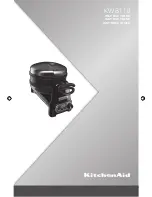
B3970
69
www.domo-elektro.be
completely. Next, gently pour a little bit of warm water into the bread pan until the
kneading paddle is under water. The sticky bits will dissolve and you will be able to
remove the kneading paddle easily.
Never use cleaning products or dishwashing brushes, for they may damage the non-
stick coating of the bread pan. The bread pan must not be cleaned in the dishwasher.
HOW TO BAKE A DELICIOUS BREAD
A few practical suggestions
• Please make sure your ingredients are at room temperature and that they are
carefully weighed. Add the ingredients in the right order. You should only use
fresh ingredients.
• The yeast needs to be the last ingredient you put in the bread pan. Put the yeast
into a little hole in the flour, thus ensuring it does not come in contact with the
added salt, sugar, water or milk. You can verify the freshness of your yeast by
submitting it to the following test: dissolve 1 teaspoonful of sugar in half a cup of
lukewarm water and subsequently add the yeast to this mixture. If the substance
starts sparkling and boiling after a few minutes, you can be sure that you are using
fresh yeast.
• Approximately 5 to 10 minutes after your breadmaker has been activated, you can
equally test the quality of the dough. The dough should look like a smooth and
elastic round ball. Open the lid and gently touch the top of the dough with your
fingers. Be careful and make sure the kneading paddle remains in action. If the
dough somewhat sticks to your fingers, this implies the dough is going to be fine.
Should the dough however stick to the bread pan, then it is probably too moist. If
the dough does not stick to your fingers at all, the pastry you are making is too dry.
• Salt brakes the effect of the yeast and sugar exactly does the opposite. If you are
not allowed to use either sugar or salt for dietary reasons, you must not add the
other ingredient either. Your bread will not contain sugar or salt.
• If you want to start baking another bread straight away, you will first have to
allow the breadmaker to cool down for 10 to 20 minutes.
• Different types of bread will have different structures and sizes, due to the
different nature of the ingredients used. These differences are completely normal
and need not to worry you.
• For some recipes, you may need to adjust the quantities, i.e. the amount of yeast,
flour or water. Never adjust all these quantities at the same time, for it will not
have any effect. Adjusting a quantity may be necessary because of the quality and
specific gravity of the flour, differences in ambient temperature or freshness of
the ingredients. Home-made bread, made with this breadmaker, does not contain
any preservatives and is therefore perishable. If you wrap the bread in a vacuum
package after cooling down, you will be able to keep it for a few days. Of course
you can also freeze the bread.
















































